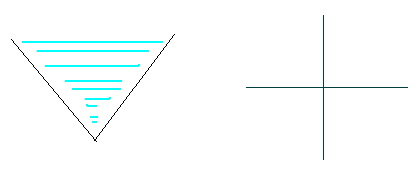An Easy Problem?! poj 2826 一道全是坑点的题!!!
来源:互联网 发布:数据库系统工程师教材 编辑:程序博客网 时间:2024/06/06 18:16
http://poj.org/problem?id=2826
Description

Your mission is to calculate how much rain these two boards can collect.
Input
Each test case consists of 8 integers not exceeding 10,000 by absolute value, x1, y1, x2, y2, x3, y3, x4, y4. (x1, y1), (x2, y2) are the endpoints of one board, and (x3, y3), (x4, y4) are the endpoints of the other one.
Output
Sample Input
20 1 1 01 0 2 10 1 2 11 0 1 2
Sample Output
1.000.00
对了之后怒交三发才缓过来 (╯‵□′)╯︵┻━┻ 谨记自己是弱鸡;
题意 给两条线 这两条线组成的图形来兜住雨水 求雨水的面积
坑点:
兜不到 上边的x >= 下边的x 同理右边小于
还有 平行,共线 ,没有交点
还可以看 discuss 也有很多值得注意的
下边是几个样例
1000
0 1 1 0
1 0 2 1
0 1 2 1
1 0 1 2
0 0 1 1
1 1 2 0
6259 2664 8292 9080 1244 2972 9097 9680
0 1 1 0
1 0 2 1
0 1 2 1
1 0 1 2
0 0 10 10
0 0 9 8
0 0 10 10
0 0 8 9
0.9 3.1 4 0
0 3 2 2
0 0 0 2
0 0 -3 2
1 1 1 4
0 0 2 3
1 2 1 4
0 0 2 3
68.22 191.66 257.23 104.97
140.25 33.53 56.71 302.58
10 10 0 0
0 0 1 1
1 1 0 0
1 1 2 2
1 1 0 0
2 2 3 3
这是运行结果
1000
0 1 1 0
1 0 2 1
1.00
0 1 2 1
1 0 1 2
0.00
0 0 1 1
1 1 2 0
0.00
6259 2664 8292 9080 1244 2972 9097 9680
6162.65
0 1 1 0
1 0 2 1
1.00
0 1 2 1
1 0 1 2
0.00
0 0 10 10
0 0 9 8
0.00
0 0 10 10
0 0 8 9
4.50
0.9 3.1 4 0
0 3 2 2
0.50
0 0 0 2
0 0 -3 2
3.00
1 1 1 4
0 0 2 3
0.75
1 2 1 4
0 0 2 3
0.00
68.22 191.66 257.23 104.97
140.25 33.53 56.71 302.58
0.00
10 10 0 0
0 0 1 1
0.00
1 1 0 0
1 1 2 2
0.00
1 1 0 0
2 2 3 3
0.00
//http://blog.sina.com.cn/s/blog_71dbfe2e0101f7zb.html//http://dev.gameres.com/Program/Abstract/Geometry.htm#矢量的概念#include<stdio.h>#include<string.h>#include<algorithm>#include<iostream>#include<stdlib.h>#include<math.h>using namespace std;const double eps=1e-8;#define zero(x) (((x) > 0 ? (x) : (-x)) < eps)double max(double a,double b){if(a > b) return a;return b ; }double min(double a,double b){if(a < b) return a;return b ; }struct point2d//点也是向量 {double x,y;point2d(double x=0,double y=0):x(x),y(y){}};struct polygon//多边形 点的集合; {point2d pp[1010];int size; };int isbanana(point2d p1,point2d p2,point2d p3,point2d p4);int fun(point2d a,point2d b,point2d c,point2d d); int isclw(point2d a,point2d b,point2d c);point2d line_cross(point2d a,point2d b,point2d c,point2d d);polygon p_h(polygon po,point2d a,point2d b);polygon p_hop(polygon po,point2d a,point2d b);void see(polygon pol);int ispolcer(polygon pol);double dis(point2d a,point2d b);void see_p(point2d a);//重载point2d operator + (point2d a,point2d b){return point2d(a.x+b.x,a.y+b.y); }point2d operator - (point2d a,point2d b){return point2d(a.x-b.x,a.y-b.y); }point2d operator * (point2d a,double b){return point2d(a.x*b,a.y*b); }point2d operator / (point2d a,double b){return point2d(a.x/b,a.y/b); }//×乘 //矢量叉积://// 计算矢量叉积是与直线和线段相关算法的核心部分。//设矢量P = ( x1, y1 ),Q = ( x2, y2 ),则矢量叉积定义为由(0,0)、//p1、p2和p1+p2所组成的平行四边形的带符号的面积,即:P × Q = x1*y2 - x2*y1,//其结果是一个标量。显然有性质 P × Q = - ( Q × P ) 和 P × ( - Q ) = - ( P × Q )。//一般在不加说明的情况下,本文下述算法中所有的点都看作矢量,//两点的加减法就是矢量相加减,而点的乘法则看作矢量叉积。// 叉积的一个非常重要性质是可以通过它的符号判断两矢量相互之间的顺逆时针关系:// 若 P × Q > 0 , 则P在Q的顺时针方向。// 若 P × Q < 0 , 则P在Q的逆时针方向。// 若 P × Q = 0 , 则P与Q共线,但可能同向也可能反向。double operator * (point2d a,point2d b){return a.x*b.y-b.x*a.y; }//·乘double pdp(point2d a,point2d b){return a.x*b.x+a.y*b.y; } double dis(point2d a,point2d b){return sqrt((a.x-b.x)*(a.x-b.x)+(a.y-b.y)*(a.y-b.y)); } //两线段是否平行int isl_l(point2d aa,point2d bb,point2d cc,point2d dd){point2d ab = aa-bb;point2d cd = cc-dd;if(cd*ab){return 0;}return 1; } //int main()//{////point2d a,b,c,d;//while(~scanf("%lf%lf%lf%lf",&a.x,&a.y,&b.x,&b.y))//{//scanf("%lf%lf%lf%lf",&c.x,&c.y,&d.x,&d.y);//printf("is %d\n",isl_l(a,b,c,d));////}//}//两线段是否香蕉(包括边界香蕉),快速排斥&&跨立实验 int isbanana(point2d aa,point2d bb,point2d cc,point2d dd) {int f1,f2; f1=fun(aa,bb,cc,dd); f2=fun(cc,dd,aa,bb); if((f1==1&&f2==1)||f1==0||f2==0||(f1==0&&f2==0)) return 1; else return 0;}int fun(point2d a,point2d b,point2d c,point2d d) { point2d p[3]; int flag,m,n; p[0].x=b.x-a.x; p[0].y=b.y-a.y; p[1].x=c.x-a.x; p[1].y=c.y-a.y; p[2].x=d.x-a.x; p[2].y=d.y-a.y; m=(p[0].x*p[1].y-p[0].y*p[1].x); n=(p[0].x*p[2].y-p[0].y*p[2].x); if((m%1000)!=0) m=m%1000; else { while((fabs((double)m/10))>10) m=m/10; } if((n%1000)!=0) n=n%1000; else { while((fabs((double)n/10))>10) n=n/10; } if(n*m<0) flag=1; else if(m*n==0) { if((c.x>=min(a.x,b.x)&&c.x<=max(a.x,b.x))&&(c.y>=min(a.y,b.y)&&c.y<=max(a.y,b.y))||(d.x>=min(a.x,b.x)&&d.x<=max(a.x,b.x))&&(d.y>=min(a.y,b.y)&&d.y<=max(a.y,b.y))) flag=0; else flag=-1; } else flag=-1; return flag; } //clockwise;也可以判断a b c是否在同一直线或c在ab那一侧// ab有顺序 int isclw(point2d a,point2d b,point2d c){double ans = (a-b)*(b-c);if(ans<0)//叉乘< 0 为顺时针返回1 return 1;if(ans==0)//同一直线 return 0;if(ans>0) return -1; } //int main()//{//point2d a,b,c;//a = point2d(0,0);//b = point2d(1,0);//c = point2d(1,-1);//printf("%d\n",isclw(a,b,c));//}//两直线焦点 point2d line_cross(point2d a,point2d b,point2d c,point2d d){double a1,b1,c1,a2,b2,c2;//a1 = a.y - b.y;//b1 = b.x - a.x;//c1 = a.x*b.y - b.x*a.y; //a*b;//a2 = c.y - d.y;//b2 = d.x - c.x;//c1 = c.x*d.y - d.x*c.y;//c*d; //double dd = a1 * b2 - a2 * b1;//printf("dd %f\n",dd);//return point2d((b1*c2-b2*c1)/dd,(c1*a2-c2*a1)/dd);//a1 = (a.y - b.y) / (a.x - b.x);//b1 = a.y - a1*(a.x);//a2 = (c.y - d.y) / (c.x - d.x);//b2 = c.y - a1*(c.x);//double xx = (b1 - b2) / (a2 - a1);//double yy = a1*xx+b1;//return point2d(xx,yy);//double lamuda = (fabs((d-a)*(b-a)))/(fabs((c-a)*(b-a)));//double xx = c.x+lamuda*(d.x-c.x);//double yy = c.y+lamuda*(d.y-c.y);// return point2d(xx,yy); double s2 = fabs((double)((d-a)*(b-a)))/2; double s1 = fabs((double)((c-a)*(b-a)))/2; return point2d((d.x*s1+c.x*s2)/(s1+s2) ,(d.y*s1+c.y*s2)/(s1+s2)); }//一个多边形与一个半平面的交集 polygon & halfpolygon p_h(polygon po,point2d a,point2d b){//printf("po.size %d\n",po.size); polygon ans; ans.size = 0; for(int i = 0;i < po.size;i++) { if(isclw(a,b,po.pp[i])>=0) { ans.pp[ans.size++] = po.pp[i]; }else if(isclw(a,b,po.pp[i])<0&&isclw(a,b,po.pp[(i+1)%po.size])>0){ans.pp[ans.size++] = line_cross(a,b,po.pp[i],po.pp[(i+1)%po.size]); } }// printf("ans %d\n",ans.size); return ans;}void see(polygon pol){printf("size %d\n",pol.size);for(int i = 0;i < pol.size;i++) { printf("%.2f %.2f \n",pol.pp[i].x,pol.pp[i].y); }}void see_p(point2d a){printf("\n point %.2f %.2f\n",a.x,a.y);} //多边形有无核 int ispolcer(polygon pol){polygon now = pol;point2d a,b;for(int i = 0;i < pol.size;i++){now = p_h(now,pol.pp[i],pol.pp[(i+1)%pol.size]);//printf("!ans %d",now.size);//see(now);if(now.size == 0) { return 0; }//printf("i %d\n",i);}return 1; } int main(){int T;scanf("%d",&T);while(T--){point2d a,b,c,d;scanf("%lf%lf%lf%lf",&a.x,&a.y,&b.x,&b.y);scanf("%lf%lf%lf%lf",&c.x,&c.y,&d.x,&d.y);if(isl_l(a,b,c,d)){printf("0.00\n");continue;}if(a.y==b.y||c.y==d.y){printf("0.00\n");continue;}if(!isbanana(a,b,c,d)){printf("0.00\n");continue;}point2d cross = line_cross(a,b,c,d);double abmaxy = max(a.y,b.y);double cdmaxy = max(c.y,d.y);point2d y1 = a;if(a.y<b.y) y1 = b;point2d y2 = c;if(c.y<d.y) y2 = d;point2d yy = y1;point2d yy_ = y2;if(y1.y<y2.y) {yy = y2; yy_ = y1;}if(cross.x<y1.x&&cross.x<y2.x){if(yy.x>=yy_.x&&yy.y>=yy_.y&&isclw(cross,yy_,yy)<0){printf("0.00\n");continue;} }if(cross.x>y1.x&&cross.x>y2.x&&isclw(cross,yy_,yy)>0){if(yy.x<=yy_.x&&yy.y>=yy_.y){printf("0.00\n");continue;} }double h = min(abmaxy,cdmaxy);point2d d1,d2;d1 = line_cross(a,b,point2d(-99999,h),point2d(99999,h));d2 = line_cross(c,d,point2d(-99999,h),point2d(99999,h));double dd = dis(d1,d2);printf("%.2f\n",(double)(h-cross.y)*dd/2);}} - An Easy Problem?! poj 2826 一道全是坑点的题!!!
- POJ 2826 An Easy Problem?! 好题
- POJ 2826 An Easy Problem?!
- poj 2826 An Easy Problem?!
- POJ 2826 An Easy Problem?!
- POJ 2826 An Easy Problem?!
- POJ 2826 An Easy Problem?!
- POJ 2826 An Easy Problem ?!
- POJ 2826 An Easy Problem?!
- Poj 2826 An Easy Problem!
- An Easy Problem?! - POJ 2826
- poj-2826 An Easy Problem?!
- poj 2826 An Easy Problem?!(线段交,细节题)
- poj 2826 An Easy Problem?!(线段交,细节题)
- poj-2826 An Easy Problem?!(计算几何,好题)
- POJ 2826 An Easy Problem?!(计算几何)
- POJ 2826 An Easy Problem?!(计算几何)
- POJ 2826 An easy problem?! 几何基础
- oracle 监听
- 第18周 C语言实战105例 例5:使用位运算符解析IP地址
- 缘是一场盛大的遇见
- 针对“除非指定了 DeleteCommand,否则数据源“SqlDataSource2”不支持删除操作”类似问题的解决
- L - Can you answer these queries?
- An Easy Problem?! poj 2826 一道全是坑点的题!!!
- 使用parted命令对linux硬盘进行操作
- 关于Visual Assist X遇到初始化失败的问题
- ie8上创建闭包失败
- POJ(3278)Catch That Cow
- HDU 5753 Permutation Bo 排列组合& 期望 多校3
- HDU - 1026 - Ignatius and the Princess I(bfs)
- 初学qt——提示窗体
- 转载使用uploadify上传大文件报 IO error #2038错误的解决方案


